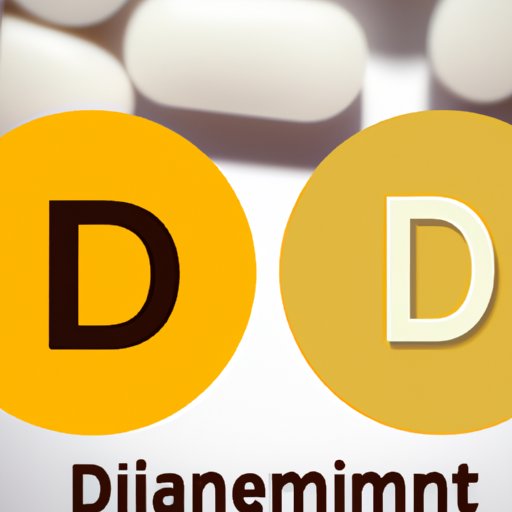Introduction
Vitamin D3 is an essential nutrient that plays a critical role in maintaining bone health, regulating immune function, and reducing the risk of chronic diseases. However, many people are deficient in vitamin D3, which can have serious health consequences. In this comprehensive guide, we will explore everything you need to know about vitamin D3, including its functions, sources, and health benefits. Whether you’re concerned about preventing osteoporosis, reducing inflammation, or boosting your overall health, understanding the importance of vitamin D3 is key.
The Ultimate Guide to Vitamin D3: Everything You Need to Know
Vitamin D3, also known as cholecalciferol, is a fat-soluble vitamin that plays a critical role in several physiological processes. Vitamin D3 helps the body absorb and use calcium and phosphorus, which are essential for maintaining bone health. It also has antimicrobial and anti-inflammatory properties that support immune function. Additionally, vitamin D3 plays a role in insulin secretion and blood pressure regulation.
The Difference Between Vitamin D3 and D2
While vitamin D2 and D3 are both forms of vitamin D, they differ in their structure and sources. Vitamin D3 is mainly produced by the skin in response to sunlight exposure, while vitamin D2 is found in plant-based sources and requires sunlight exposure to metabolize. Vitamin D3 is believed to be more effective at raising and maintaining vitamin D levels in the body.
How the Body Absorbs and Uses Vitamin D3
Vitamin D3 is absorbed through food, supplements, or sunlight exposure. Once in the body, vitamin D3 is converted into its active form, calcitriol, in the liver and kidneys. Calcitriol helps the body absorb and use calcium and phosphorus, which are essential for bone health. Vitamin D3 also supports immune function and has anti-inflammatory properties. However, too much vitamin D3 can be toxic and lead to hypercalcemia, a condition characterized by high levels of calcium in the blood.
Why Vitamin D3 is Critical to Your Health and How to Ensure You Get Enough
Health Benefits of Vitamin D3
Vitamin D3 plays a crucial role in promoting bone health, reducing the risk of osteoporosis and fractures. Additionally, vitamin D3 has been shown to reduce the risk of chronic diseases such as cancer, heart disease, and type 2 diabetes. Vitamin D3 also supports immune function and may protect against respiratory infections, such as the flu. Studies have also linked vitamin D3 deficiency to autoimmune diseases, depression, and cognitive impairment.
Sources of Vitamin D3
The primary source of vitamin D3 is sunlight exposure, as the skin produces vitamin D3 when exposed to ultraviolet B (UVB) radiation. However, factors such as geographic location, season, time of day, and skin pigmentation affect the amount of vitamin D3 produced through sun exposure. Additionally, vitamin D3 can be obtained through dietary sources such as fatty fish, egg yolks, and fortified foods. Supplements are also available in the form of capsules, tablets, or liquid drops.
Vitamin D3: The Sunshine Vitamin Explained
How Sunlight Exposure Helps the Body Produce Vitamin D3
When the skin is exposed to UVB radiation, a form of vitamin D3 called 7-dehydrocholesterol is converted into vitamin D3. The amount of vitamin D3 produced depends on factors such as exposure time, skin pigmentation, and latitude. For example, people living in the northern latitudes receive less UVB radiation during the winter months and are at higher risk of vitamin D3 deficiency.
Factors That Affect the Amount of Vitamin D3 Produced Through Sun Exposure
Several factors influence the amount of vitamin D3 produced through sunlight exposure, including:
– Time of day: Vitamin D3 production is highest between 10 am and 3 pm.
– Latitude: People living at latitudes above 37 degrees north or below 37 degrees south are at higher risk of deficiency.
– Skin pigmentation: Darker skin produces less vitamin D3 than lighter skin.
– Clothing and sunscreen use: Covering the skin or using sunscreen can reduce vitamin D3 production.
Tips for Safe and Adequate Sunlight Exposure
While sunlight exposure is the most effective way to produce vitamin D3, it’s essential to practice safe sun habits to prevent skin damage and skin cancer. Here are some tips for safe and adequate sunlight exposure:
– Aim for 10-30 minutes of unprotected sun exposure per day, depending on skin type and location.
– Avoid prolonged exposure during peak sun hours (10 am-3 pm).
– Wear protective clothing and hats to cover exposed skin.
– Use broad-spectrum sunscreen with an SPF of at least 30 when exposed to longer periods of sunlight.

The Benefits of Vitamin D3 and How to Incorporate it Into Your Diet
Food Sources of Vitamin D3
Foods that naturally contain vitamin D3 include fatty fish such as salmon, mackerel, and tuna, as well as egg yolks. Some foods such as dairy products, cereals, and orange juice are fortified with vitamin D3. However, it’s difficult to consume enough vitamin D3 through diet alone, which is why sunlight exposure and supplementation are necessary.
Recommended Dietary Intakes of Vitamin D3
The recommended dietary intake of vitamin D3 varies depending on age, sex, and other factors. The National Institutes of Health recommends the following dietary intakes of vitamin D3:
– Infants 0-12 months: 400-1,000 IU per day
– Children 1-18 years: 600-1,000 IU per day
– Adults 19-70 years: 600-800 IU per day
– Adults over 70 years: 800-1,000 IU per day
Ideas for Incorporating Vitamin D3-Rich Foods into Meals
Incorporating vitamin D3-rich foods into your diet can be a delicious and healthy way to boost your vitamin D3 levels. Here are some ideas for incorporating vitamin D3-rich foods into your meals:
– Grill or bake fatty fish such as salmon or mackerel.
– Add egg yolks to breakfast dishes such as omelets or frittatas.
– Drink fortified milk or orange juice with added vitamin D3.
– Snack on vitamin D3-rich mushrooms.
Vitamin D3: The Key to Strong Bones and Immunity
How Vitamin D3 Supports Bone Health and Prevents Osteoporosis
Vitamin D3 is essential for maintaining bone health by promoting calcium absorption and bone mineralization. Without enough vitamin D3, bones become weak and brittle, leading to osteoporosis and an increased risk of fractures. Studies have shown that supplementing with vitamin D3 can improve bone density and reduce fracture risk, particularly in older adults.
The Role of Vitamin D3 in Regulating the Immune System and Reducing Inflammation
Vitamin D3 plays a critical role in supporting immune function by regulating the production of cytokines, which are proteins that play a role in inflammation and infection. Vitamin D3 deficiency is associated with an increased risk of respiratory infections, such as the flu and pneumonia. Additionally, vitamin D3 has been shown to reduce inflammation and oxidative stress, which are involved in the development of several chronic diseases.
The Link Between Vitamin D3 Deficiency and Autoimmune Diseases
Research has shown that vitamin D3 deficiency may contribute to the development of autoimmune diseases, such as multiple sclerosis, rheumatoid arthritis, and type 1 diabetes. This may be due to vitamin D3’s role in regulating immune function and reducing inflammation. However, more research is needed to determine the exact mechanism by which vitamin D3 affects autoimmune diseases.
Why Vitamin D3 Deficiency is Common and How to Detect and Treat It
Factors That Contribute to Vitamin D3 Deficiency
Several factors contribute to vitamin D3 deficiency, including:
– Limited sunlight exposure
– Skin covered with clothing and sunscreen
– Living at higher latitudes
– Darker skin pigmentation
– Obesity
– Age
– Malabsorption disorders
Symptoms and Health Effects of Vitamin D3 Deficiency
Vitamin D3 deficiency can lead to several health consequences, including:
– Osteoporosis and fractures
– Muscle weakness and pain
– Increased risk of infections
– Cardiovascular disease
– Autoimmune diseases
Symptoms of vitamin D3 deficiency may include fatigue, joint pain, muscle weakness, and frequent infections. However, many people with vitamin D3 deficiency may not have any symptoms.
Tests and Medical Treatments for Vitamin D3 Deficiency
If you suspect that you have vitamin D3 deficiency, your doctor can perform a blood test to measure your levels of 25-hydroxyvitamin D3, the storage form of vitamin D3. Treatment for vitamin D3 deficiency typically involves vitamin D3 supplements, either in the form of tablets, capsules, or liquid drops. In severe cases, UV light therapy may be used to increase vitamin D3 levels.
Conclusion
In conclusion, vitamin D3 is an essential nutrient that plays a critical role in maintaining bone health, regulating immune function, and reducing the risk of chronic diseases. Despite its importance, many people are deficient in vitamin D3, which can result in serious health consequences. To ensure that you get enough vitamin D3, it’s important to get adequate sunlight exposure, consume vitamin D3-rich foods, and consider supplementation if necessary. By taking these steps, you can optimize your vitamin D3 levels and enjoy the many health benefits that it provides.
